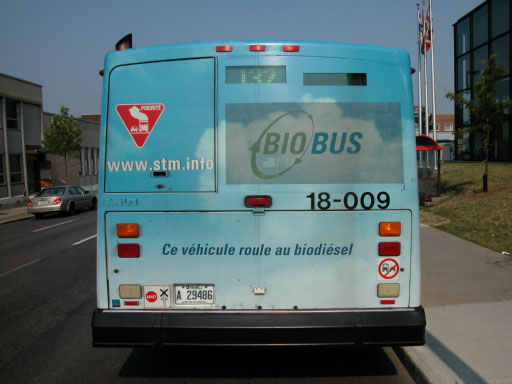By: Virago

Modifications to a vehicle's motor are only necessary when using B-20 or higher regularly, in which case the related costs are minor. Biodiesel will dissolve rubber over time, thus rubber components will eventually need to be replaced by those made of synthetic rubber. Contrary to the STM's cost argument, these rubber components are mostly hoses and gaskets - all relatively inexpensive parts to buy. In terms of engine parts and necessary changes, biodiesel will actually save the company money in the long run. According to soyatech.com, "the addition of biodiesel to regular diesel actually increases the lubricity of the fuel, reducing wear and extending the life of engine components"1 (www.soyatech.com) - something our old city buses could surely benefit from.
Biodiesel pumps.jpg
As it currently stands, biodiesel is available in range of mixtures from as low as B-5 (5% with 95% diesel) to the full 100% (B-100) - all of which are readily available to the STM.(cum sent) Olco, their official provider, was awarded the handsome government contract to supply both diesel and biodiesel fuel for the duration of the project. The STM's argument about availability of the fuel in question really only applies to us little people. While several major cities across Canada and the US each offer multiple biodiesel fuel-up locations to the public, Montreal's sole biodiesel supplier recently closed. This company originally began processing the biofuel for their own fleet and thoughtfully decided to make their small surplus amount available to other environmentally-conscious individuals. After all, pure biodiesel produces 78% less CO2 emissions than diesel, and reduces most forms of air pollutionpollution2 (www.biodieselgear.com). But sadly, they could no longer keep up with the demand. Though these shortages are fortunately of no concern to the STM, they still continue to pride themselves on their 95% dirty diesel "biodiesel".
All in all, it is great that the STM is using biodiesel, however little the amount, but they should be more honest and forthcoming with the facts. Though 5% is better than nothing, does slightly better than nothing really earn the right to boast a deceiving phrase on each bio bus, misleading the population to believe they are doing much more for the environment? Cost, temperature and availability - the company's most overused arguments against increasing biodiesel amounts to drastically reduce emissions have been rebutted. They have the option, the image and the government funding, so why exactly are they choosing to pollute far more than they need to?
* "Ce véhicule roule au biodiésel" means "This bus rolls on biodiesel"
References:
Soyatech. "Biodiesel Facts." Biodiesel Facts. Www.soyatech.com, 2000. Web. 16 May 2012.
National Renewable Energy Laboratory. Biodiesel--the Clean, Green Fuel for Diesel Engines. Publication no. DOE/GO-102000-1048. Http://www.biodieselgear.com. US Department of Energy (DOE), May 2000. Web. 16 May 2012.

Leave a comment